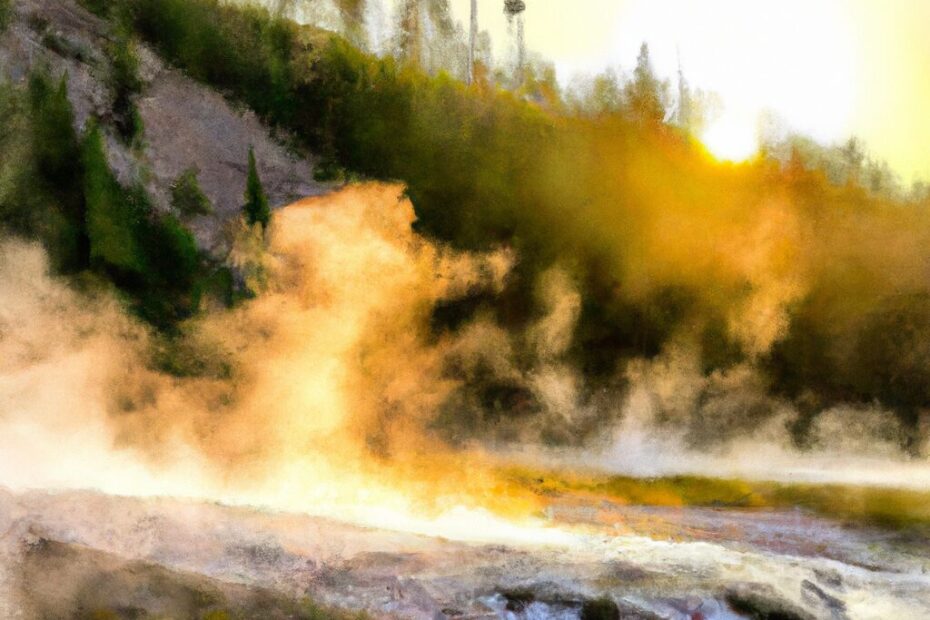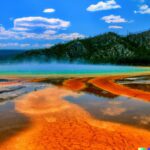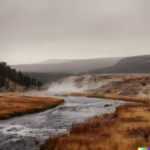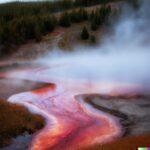National Parks are renowned for their stunning and distinctive natural features. In this article, we’ll take a closer look at the captivating world of geysers, with a focus on the famous Old Faithful.
We’ll uncover the distinctive qualities that make Old Faithful stand out, including its eruption patterns and size. We’ll also explore the location of other geysers in the vicinity and the various thermal features surrounding Old Faithful. Additionally, we’ll delve into the formation and causes of geyser eruptions and the methods used to monitor and study these incredible phenomena.
Get ready to be amazed by the fascinating world of geysers!
What Are Geysers?
Geysers are natural wonders commonly found in geothermal areas such as Yellowstone National Park. They are characterized by intermittent eruptions of hot water and steam resulting from geothermal activity and volcanic landscapes.
Geysers are remarkable phenomena that occur when underground water is heated by the Earth’s core and erupts through narrow vents in the crust. This process is caused by extreme temperatures that cause the water to flash into steam. The main heat source for geysers is magma chambers and the circulation of water through porous rock formations.
These geological wonders serve as important indicators of geothermal activity and provide insight into the Earth’s internal heat processes. Additionally, their association with geothermal energy makes them valuable for harnessing renewable energy sources.
What Makes Old Faithful Unique?
Old Faithful, a famous geyser in Yellowstone National Park, is renowned for its predictable and impressive eruptions. It is a significant tourist attraction and a subject of scientific research due to its ecological and historical significance.
Located in Yellowstone National Park, Old Faithful is known for its consistent eruptions that occur every 90 minutes. These eruptions provide valuable insights into the dynamics of geothermal activity for researchers.
The geyser’s geological characteristics, including its cone shape and thermal features, make it a symbol of the park’s unique natural wonders. They also add to its historical significance. Efforts towards environmental conservation in the area aim to preserve the delicate balance of this ecosystem, ensuring that future generations can continue to study and enjoy Old Faithful.
What Is the Eruption Pattern of Old Faithful?
The eruption pattern of Old Faithful follows a relatively predictable schedule, offering visitors the opportunity to witness its majestic eruptions amidst the natural beauty of the geyser basin. This contributes to the park’s appeal for outdoor adventure enthusiasts and highlights its role in maintaining the ecological balance of the ecosystem.
Eruptions occur approximately every 60 to 110 minutes, with an average height of 130 feet and lasting between 1.5 to 5 minutes. This regularity of eruptions provides a unique chance for hikers, nature enthusiasts, and wildlife observers to plan their visits around this natural spectacle.
The geothermal activity from Old Faithful influences the surrounding vegetation and wildlife, contributing to the delicate ecological balance of Yellowstone National Park.
What Is the Size of Old Faithful?
Old Faithful, one of the largest geysers in Yellowstone National Park, stands as a prominent landmark and natural wonder, attracting visitors to witness its magnificent eruptions and explore the unique geothermal features of the park in Wyoming.
Yellowstone National Park’s iconic Old Faithful geyser is a sight to behold. Its towering eruptions, reaching heights between 100-180 feet, occur approximately every 90 minutes, captivating onlookers with its predictability and power.
But its significance goes beyond its size. Old Faithful holds historical importance as one of the first sites to be designated within a national park. Its breathtaking displays inspire awe and highlight the natural forces at work within Yellowstone, making it a must-see for those seeking to experience the park’s geological marvels.
Where Are the Geysers Near Old Faithful Located?
The geysers near Old Faithful are situated within the captivating landscape of Yellowstone National Park, offering visitors an array of natural wonders and attractions to explore in the scenic wilderness of Wyoming.
This region is renowned for its thermal features, including the iconic geysers that shoot streams of boiling water into the air, creating a mesmerizing spectacle against the backdrop of the park’s diverse ecosystems.
The colorful mineral deposits surrounding these geysers add a unique and otherworldly quality to the area, attracting photographers and nature enthusiasts alike.
Visitors can wander along boardwalks to witness these geological marvels up close, feeling the raw power of nature as they stand in awe of the steam and thunderous eruptions that punctuate the serene surroundings.
What Are the Names of the Geysers Near Old Faithful?
The geysers near Old Faithful encompass a diverse range of names, each contributing to the unique geothermal features of Yellowstone National Park. The visitor center and park rangers serve as valuable resources for exploring these natural phenomena.
Yellowstone National Park is home to several noteworthy geysers, including Beehive Geyser. This geyser is renowned for its impressive eruptions, which can reach heights of up to 200 feet.
Riverside Geyser is another popular attraction, known for its picturesque location along the Firehole River and its predictable eruptions. And let’s not forget about Castle Geyser, with its distinct cone shape and occasional bursts of water and steam.
These geysers, along with others in the area, contribute to the captivating geothermal landscape that makes Yellowstone a natural wonder.
What Is the Distance Between Old Faithful and the Other Geysers?
The distance between Old Faithful and the other geysers within Yellowstone National Park provides visitors with the opportunity to experience a diverse array of geothermal activity and natural beauty, contributing to the park’s appeal for outdoor adventure and the preservation of ecological balance within the ecosystem.
The geysers in the vicinity showcase the dynamic nature of geothermal features, offering a unique chance to witness the raw power of earth’s forces.
As visitors explore beyond Old Faithful, they encounter a network of bubbling hot springs, colorful microbial mats, and steaming fumaroles, creating a surreal landscape. These natural wonders not only inspire awe but also underscore the importance of preserving this ecological balance.
It’s evident that Yellowstone National Park encapsulates a harmonious coexistence between geothermal wonders and the diverse flora and fauna thriving within its boundaries.
What Are the Other Thermal Features Near Old Faithful?
In addition to geysers, the vicinity near Old Faithful offers an array of captivating thermal features, including hot springs, fumaroles, mud pots, and geothermal vents, contributing to the mesmerizing geothermal landscape of Yellowstone National Park.
The hot springs in the area showcase stunning colors created by thermophilic microorganisms thriving in the warm waters. Fumaroles release steam and gases, often accompanied by an otherworldly hissing sound.
Mud pots exhibit a unique blend of water, mud, and gases, creating a boiling and bubbling spectacle. Geothermal vents emit hot steam, creating a dynamic and dramatic display. These diverse thermal features collectively showcase the remarkable and dynamic geothermal activity found in the region.
What Are the Hot Springs Near Old Faithful?
The hot springs near Old Faithful contribute to the remarkable volcanic landscape of Yellowstone National Park, showcasing a diverse array of thermal pools and geological formations amidst the natural beauty of the park’s surroundings.
The vibrant colors and unique shapes of the terraces and cascading pools at the park are a testament to the geological forces at work. These thermal wonders are created by mineral-rich waters in the park’s active volcanic environment, where the Earth’s internal heat gives rise to these enchanting natural marvels.
As visitors explore the park, they can witness the steam rising from the vividly colored pools and the bubbling hot springs, creating a mesmerizing juxtaposition against the lush greenery and rugged terrain. It’s a truly breathtaking sight to behold.
What Are the Fumaroles Near Old Faithful?
The fumaroles near Old Faithful represent mesmerizing geothermal phenomena, characterized by the release of steam from the earth’s surface, contributing to the diverse geological formations and unique geothermal features of Yellowstone National Park.
They are captivating examples of the Earth’s natural wonders, often displaying vibrant colors due to the varied mineral deposits.
These fumaroles are intricately linked to the park’s volcanic history, with their presence shaping the dramatic landscapes and thermal pools that enthrall visitors. Their continuous activity serves as a reminder of the ever-changing nature of the Earth’s crust, showcasing the powerful forces at work beneath the surface.
What Are the Mud Pots Near Old Faithful?
The mud pots near Old Faithful showcase the intriguing sight of boiling water and mud, representing a unique manifestation of geothermal activity and contributing to the diverse geological formations and ecological significance within Yellowstone National Park.
These mud pots are a result of the interaction between hot water and surface water or steam, creating a mix of mud and clay that bubbles and boils, producing a mesmerizing display.
This geothermal activity is not only a visual spectacle but also plays a crucial role in sustaining unique ecosystems and biodiversity within the park, as it creates specialized habitats for certain microorganisms and contributes to the overall balance of the park’s ecosystem.
How Do Geysers Form?
The formation of geysers is attributed to the interplay of geothermal activity, a reliable heat source, and specific geological formations, resulting in the creation of unique geothermal features that manifest as mesmerizing hot springs and steam geysers.
Geothermal activity is a key factor in the formation of geysers. This process involves heat from the Earth’s core rising towards the surface. The heat source usually comes from magma chambers or heated rock formations, providing the necessary energy to heat the water.
In addition, specific geological formations, like underground channels and chambers, play a role in the creation of geysers. These formations contribute to the build-up of pressure and containment of superheated water. The combination of these factors leads to the spectacular eruptions and displays that define geysers.
What Causes the Eruptions of Geysers?
The eruptions of geysers are primarily caused by the build-up of pressure within geothermal vents, coupled with the influence of heat sources and volcanic activity, leading to the spectacular release of boiling water and steam in intermittent bursts.
Geothermal vents are openings in the Earth’s crust that allow underground water to mix with hot rocks, creating immense pressure. These heat sources, such as magma chambers, contribute to the boiling temperatures of the water.
Volcanic activity in the vicinity can trigger or enhance geyser eruptions, further emphasizing the dynamic relationship between geysers and volcanic processes. Predicting geyser eruptions requires a deep understanding of these complex interplays, and advancements in monitoring technology and scientific research are contributing to improved eruption prediction capabilities.
How Are Geysers Monitored and Studied?
Geysers are rigorously monitored and studied by park rangers and scientific researchers to assess their ecological and geological significance, contributing to ongoing efforts in environmental conservation, natural habitat preservation, and biodiversity preservation.
Understanding the behavior and dynamics of geysers is crucial for deciphering the complex interactions between geological processes and the surrounding ecosystem. Through continuous observation and research, scientists gain valuable insights into how geysers influence the environment and support diverse forms of life. This knowledge aids in developing effective conservation strategies, ensuring that these unique natural features are protected for future generations.
Studying geysers offers a window into the Earth’s geothermal activity, providing valuable data for scientific understanding and potentially sustainable energy sources.
Frequently Asked Questions
What are the geysers near Old Faithful in Yellowstone?
The geysers near Old Faithful in Yellowstone are a group of hot springs that are known for their reliability in erupting at regular intervals.
Where are the geysers near Old Faithful located in Yellowstone?
The geysers near Old Faithful are located in the Upper Geyser Basin, which is in the southwestern section of Yellowstone National Park.
What is the most famous geyser near Old Faithful in Yellowstone?
The most famous geyser near Old Faithful is, of course, the Old Faithful geyser itself. It is one of the most iconic and predictable geysers in the world.
How often does Old Faithful geyser erupt?
Old Faithful geyser erupts approximately every 90 minutes, with eruptions lasting 1.5 to 5 minutes. This occurs due to a buildup of pressure in the underground water system.
Are there other geysers near Old Faithful in Yellowstone besides Old Faithful?
Yes, there are several other geysers near Old Faithful, including Castle Geyser, Grand Geyser, and Riverside Geyser. These geysers also have regular eruptions and can often be seen in close proximity to Old Faithful.
Can I visit the geysers near Old Faithful in Yellowstone year-round?
Yes, you can visit the geysers near Old Faithful in Yellowstone year-round. However, access to certain areas may be limited during the winter due to heavy snowfall. It is best to check the park’s website for current conditions before planning your visit.
Last Updated on January 25, 2024 by Jon Waraas – Originally Posted: January 25, 2024

I’m Jon Waraas, and I’ve been navigating the online world since 2006. By day, I’m the proud owner of some eCommerce gems, and by night, I’m the voice behind the adventures on Waraas.Com.
My heart, however, belongs to the wild beauty of Yellowstone National Park. I’ve got a collection of websites dedicated to sharing the wonders of this natural masterpiece. Oh, and did I mention? I’m currently building my own cabin inside the ghost town of Gilmore, Idaho – a cabin with tales to tell!
When I’m not immersed in the digital realm, you’ll find me lacing up my boots for a good hike or setting up camp under the star-studded sky.




